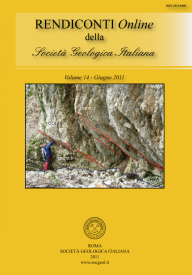
I vulcani nella Carta Geologica d'Italia: i risultati della sperimentazione basata sull'uso di UBSU e di altre unità stratigrafiche
Roberto Bonomo (*), Valeria Ricci (*) & Letizia Vita (*)
(*) ISPRA, Via Curtatone 3, 00185 Roma. E-mail: roberto.bonomo@isprambiente.it
DOI: https://doi.org/10.3301/ROL.2011.06
Volume: 14/2011
Pages: 62-74
Abstract
Within the framework of the national Geological Mapping Project at 1:50.000 scale (CARG), since the late 1980s the Geological Survey of Italy (GSI) financed the realization of 55 sheets where volcanic deposits are present with various extensions. The main areas interested by the 1:10.000 surveys are the active volcanic districts of Etna, Vesuvius, Phlegrean Fields and Ischia island, as well as those interested by Pleistocene volcanism. Moreover, ancient volcanism of Alps and Sardinia, also covered by the surveys, contributed to renovate this geological cartography.
With the aim to produce an up-to-date, useful, innovative, official Geological Map, at the beginning of the CARG Project, GSI asked to the CNR Commission for Geological Cartography and Geomorphology (CG) to edit the Guide-books for Cartography in volcanic areas (Servizio Geologico Nazionale, 1992). In particular, referring to detailed studies by Ferrrrari et alii (1989a, b), Neri et alii (1991), Calvari et alii (1994), Coltelli et alii (1994), CG indicated the Unconformity-Bounded Stratigraphic Units (UBSU) be the stratigraphic units to be used in the cartographic representation of volcanic areas. CG indeed considered UBSU the best units to reconstruct both the eruptive history of a volcano and the geometric and stratigraphic relationships between the deposits coming from other volcanic centres, as well as the significant correlations with the adjacent different depositional environments.
During the work-in-progress of the CARG Project, GSI has supported the CG's Guide-lines (APAT, 2005); however this new methodology needed an experimental application on field in order to test its potentialities and limits. So, considering the necessity of some flexibility in the application during the experimental stage, GSI allowed the Authors of the maps, to diversify this methodology, in accordance with the various volcanic contexts. Now most of the maps interesting the whole case histories of Italian volcanism are almost complete and it is possible to focus the results. As a consequence, we have more knowledge of critical expects and together with the Scientific Community we can make a careful study of the problems in order to obtain "mature" and, as much as possible, sharing standard methodologies, both in cartography and in terminology.
In this paper we show some examples of the new official cartography in volcanic areas in which the UBS units and Lithosomes have been used for the first time, together with the traditional lithostratigraphic units, through a generally integrated approach. In the realization of the CARG sheets, the Authors of the cartography of the volcanic areas used three main stratigraphic approaches. These have been analyzed in order to evidence their advantages and good results, as well as the stratigraphic problems which need some study yet, such as the criteria of lithostratigraphic formalization of volcanic units, the criteria of both hierarchical assignment to UBS units and exportability of their unconformities among different geological contexts and, finally, the use of the lithosomes in volcanic areas.
In conclusion, although some questions are still open, we point out the originality of this cultural operation that involves some key question and investigation for the future prospects.
Keywords
Get Full Text